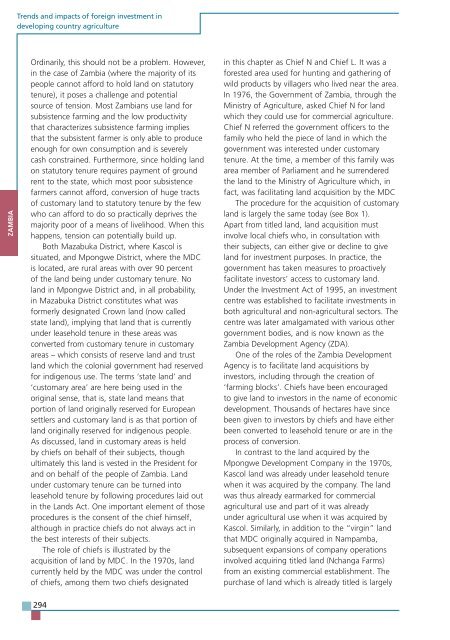TRENDS AND IMPACTS OF FOREIGN INVESTMENT IN DEVELOPING COUNTRY AGRICULTURE
TRENDS AND IMPACTS OF FOREIGN INVESTMENT IN DEVELOPING COUNTRY AGRICULTURE
TRENDS AND IMPACTS OF FOREIGN INVESTMENT IN DEVELOPING COUNTRY AGRICULTURE
Create successful ePaper yourself
Turn your PDF publications into a flip-book with our unique Google optimized e-Paper software.
ZAMBIA<br />
Trends and impacts of foreign investment in<br />
developing country agriculture<br />
Ordinarily, this should not be a problem. However,<br />
in the case of Zambia (where the majority of its<br />
people cannot afford to hold land on statutory<br />
tenure), it poses a challenge and potential<br />
source of tension. Most Zambians use land for<br />
subsistence farming and the low productivity<br />
that characterizes subsistence farming implies<br />
that the subsistent farmer is only able to produce<br />
enough for own consumption and is severely<br />
cash constrained. Furthermore, since holding land<br />
on statutory tenure requires payment of ground<br />
rent to the state, which most poor subsistence<br />
farmers cannot afford, conversion of huge tracts<br />
of customary land to statutory tenure by the few<br />
who can afford to do so practically deprives the<br />
majority poor of a means of livelihood. When this<br />
happens, tension can potentially build up.<br />
Both Mazabuka District, where Kascol is<br />
situated, and Mpongwe District, where the MDC<br />
is located, are rural areas with over 90 percent<br />
of the land being under customary tenure. No<br />
land in Mpongwe District and, in all probability,<br />
in Mazabuka District constitutes what was<br />
formerly designated Crown land (now called<br />
state land), implying that land that is currently<br />
under leasehold tenure in these areas was<br />
converted from customary tenure in customary<br />
areas – which consists of reserve land and trust<br />
land which the colonial government had reserved<br />
for indigenous use. The terms ‘state land’ and<br />
‘customary area’ are here being used in the<br />
original sense, that is, state land means that<br />
portion of land originally reserved for European<br />
settlers and customary land is as that portion of<br />
land originally reserved for indigenous people.<br />
As discussed, land in customary areas is held<br />
by chiefs on behalf of their subjects, though<br />
ultimately this land is vested in the President for<br />
and on behalf of the people of Zambia. Land<br />
under customary tenure can be turned into<br />
leasehold tenure by following procedures laid out<br />
in the Lands Act. One important element of those<br />
procedures is the consent of the chief himself,<br />
although in practice chiefs do not always act in<br />
the best interests of their subjects.<br />
The role of chiefs is illustrated by the<br />
acquisition of land by MDC. In the 1970s, land<br />
currently held by the MDC was under the control<br />
of chiefs, among them two chiefs designated<br />
294<br />
in this chapter as Chief N and Chief L. It was a<br />
forested area used for hunting and gathering of<br />
wild products by villagers who lived near the area.<br />
In 1976, the Government of Zambia, through the<br />
Ministry of Agriculture, asked Chief N for land<br />
which they could use for commercial agriculture.<br />
Chief N referred the government officers to the<br />
family who held the piece of land in which the<br />
government was interested under customary<br />
tenure. At the time, a member of this family was<br />
area member of Parliament and he surrendered<br />
the land to the Ministry of Agriculture which, in<br />
fact, was facilitating land acquisition by the MDC<br />
The procedure for the acquisition of customary<br />
land is largely the same today (see Box 1).<br />
Apart from titled land, land acquisition must<br />
involve local chiefs who, in consultation with<br />
their subjects, can either give or decline to give<br />
land for investment purposes. In practice, the<br />
government has taken measures to proactively<br />
facilitate investors’ access to customary land.<br />
Under the Investment Act of 1995, an investment<br />
centre was established to facilitate investments in<br />
both agricultural and non-agricultural sectors. The<br />
centre was later amalgamated with various other<br />
government bodies, and is now known as the<br />
Zambia Development Agency (ZDA).<br />
One of the roles of the Zambia Development<br />
Agency is to facilitate land acquisitions by<br />
investors, including through the creation of<br />
‘farming blocks’. Chiefs have been encouraged<br />
to give land to investors in the name of economic<br />
development. Thousands of hectares have since<br />
been given to investors by chiefs and have either<br />
been converted to leasehold tenure or are in the<br />
process of conversion.<br />
In contrast to the land acquired by the<br />
Mpongwe Development Company in the 1970s,<br />
Kascol land was already under leasehold tenure<br />
when it was acquired by the company. The land<br />
was thus already earmarked for commercial<br />
agricultural use and part of it was already<br />
under agricultural use when it was acquired by<br />
Kascol. Similarly, in addition to the “virgin” land<br />
that MDC originally acquired in Nampamba,<br />
subsequent expansions of company operations<br />
involved acquiring titled land (Nchanga Farms)<br />
from an existing commercial establishment. The<br />
purchase of land which is already titled is largely


